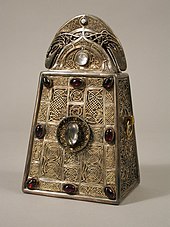Domnall Ua Lochlainn

Domhnall Ua Lochlainn (old spelling: Domnall Ua Lochlainn) (1048 – 10 February 1121), also known as Domhnall Mac Lochlainn (old spelling: Domnall Mac Lochlainn),
High Kingship after Máel Sechnaill

The meaning, and even the definition, of the High Kingship of Ireland to which Domnall laid claim was far from clear in the period after the death of the last traditional Uí Néill king of Tara, Máel Sechnaill mac Domnaill of Clann Cholmáin, in 1022. Later, rival kings produced differing definitions. Domnall's legal men, for example, claimed that a High King "with opposition" was the king of a province who could lead his army throughout Ireland without defeat, and this Domnall could do. The supporters of his southern rival, Muirchertach Ua Briain of Munster, disagreed, and said a High King "without opposition" should control three great port cities of Ireland: Dublin, Waterford, and Limerick, cities over which Muirchertach exercised some control.[2]
Regardless of legal frictions, the first king to construct something resembling an over-lordship of Ireland after the death of Máel Sechnaill was
Diarmait's position was quickly taken by his former ally Toirdelbach Ua Briain. Ua Briain installed his son, Muirchertach in Dublin, and campaigned in Ulster. In Leinster and Connacht he pursued a policy of setting rival families against each other. Domnall Ua Lochlainn, on his coming to power in 1084, was left undisturbed by Ua Briain, who fell ill the following year and died in 1086, aged 77. At his death, even the partisan northern annals recognized Toirdelbach Ua Briain as king of Ireland.[5]
Origins
Domnall was the son of a certain Ardgar son of Lochlann.
In the years before Domnall, the Cenél nEógain had been largely bereft of effective leadership, so much so that Conchobar Ua Briain of Munster, cousin and bitter enemy of Toirdelbach, had been invited to take the kingship of the
Domnall became
However, Muirchertach Ua Briain the new king of Munster (a matrilineal kinsman of Toirdelbach), moved to oppose the rule of Meic Lochlainn between 1101 and 1119.
Death and after
Domnall's glowing obituary in the Annals of Ulster reads as follows:
Domnall son of Ardgar son of Lochlann, over-king of Ireland, pre-eminent among the Irish in form and lineage, in sense and valour, in happiness and prosperity, in giving valuables and food, died in Daire Coluim Cille in the thirty-eighth year of his reign, the seventy-third year of his age, on Wednesday night, the fourth of the Ides [i.e. 10 February 1121] and the eighteenth of the moon, the feast of Mo-Chuaróc the wise.[10]
Notes
- ^ Ua Lochlainn and its replacement Mac Lochlainn are surnames, from which the modern Irish surnames McLaughlin, O'Loughlin and MacLoughlin are derived. They should be distinguished from ua Lochlainn and mac Lochlainn, usually meaning grandson and son of Lochlann respectively.
- ^ Ó Cróinín, Early Medieval Ireland, pp. 273–277; Griffin, The Mac Lochlainn High-Kingship, pp. 10–11.
- ^ Byrne, pp. 271–272; Ó Cróinín, pp. 277–278.
- ^ Annals of Ulster, s.a. 1072.
- ^ Ó Cróinín, Early Medieval Ireland, pp. 278–279; Annals of Ulster, s.a. 1086.
- ^ Griffin, The Mac Lochlainn High-Kingship, pp. 4–5 & 9–10; Byrne, Irish Kings, p. 284. The proposed descent is no novelty, being that presented by James Henthorn Todd in his 1867 Rolls Series edition of the Cogadh Gaedhel Re Gallaibh, p. cxcviii, note 1.
- ^ Bracken, "Toirdelbach".
- ^ Flanagan.
- ^ Annals of Ulster, s.a. 1083.
- ^ Annals of Ulster, s.a. 1121.
References
- The Annals of Ulster AD 431–1201, CELT: Corpus of Electronic Texts, 2003, retrieved 10 February 2007
- Bracken, Damian (2004), "Ua Briain, Muirchertach [Murtagh O'Brien] (c.1050–1119)", Oxford Dictionary of National Biography, Oxford: Oxford University Press, retrieved 6 March 2008
- Bracken, Damian (2004), "Ua Briain, Toirdelbach [Turlough O'Brien] (1009–1086)", Oxford Dictionary of National Biography, Oxford: Oxford University Press, retrieved 6 March 2008
- ISBN 1-85182-196-1
- Flanagan, Marie Therese; Harrison, B. (2004), "Ua Lochlainn, Domnall", Oxford Dictionary of National Biography, , retrieved 7 January 2008
- Flanagan, Marie Therese (2005), "High-kings with opposition, 1072–1166", in Ó Cróinín, Dáibhí (ed.), Prehistoric and Early Ireland, A New History of Ireland, vol. I, Oxford: Oxford University Press, pp. 899–933, ISBN 978-0-19-922665-8
- Griffin, Patrick C. (2002), The Mac Lochlainn High-Kingship in Late Pre-Norman Ireland., Unpublished M. Phil. thesis, Trinity College Dublin, retrieved 11 May 2008
- Lydon, James (2003), The Lordship of Ireland in the Middle Ages (2nd ed.), Dublin: Four Courts Press, ISBN 1-85182-737-4
- ISBN 0-582-01565-0
- Simms, Katherine (2004), "Ua Conchobair, Toirdelbach Mór (1088–1156) [Turlough the Great O'Connor] (1088–1156)", Oxford Dictionary of National Biography, Oxford: Oxford University Press, retrieved 6 March 2008
